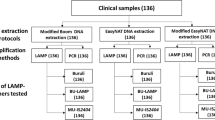Summary
Conclusion: Preparation of DNA from pancreatic juice for subsequent polymerase chain reaction (PCR) is difficult, but manageable. The protocol presented offers a simple and fast solution. This method might be applicable to other complicated samples, such as saliva, wound secretions, or stool washings.
Background: Of all the biological samples used for PCR amplification, pancreatic juice is the most problematic because of the presence of potential inhibitory substances and the amount of nucleases. This demands a DNA preparation procedure that is suitable for routine diagnostic PCR, and is therefore efficient and safe. This is particularly true for pancreatic juice obtained during routine endoscopy.
Methods: We describe here a simple method utilizing modified phenol/chloroform extraction and precipitation directly from native pancreatic juice suitable for diagnostic PCR applications, such as oncogenes.
Results: DNA could be prepared in quantitative amounts from routine endoscopic specimens. DNA could also be prepared from samples kept several days at room temperature.
Similar content being viewed by others
References
Löhr M, Brenner DA, Rooney JF, Nelson JA. Application of the polymerase chain reaction in gastrointestinal endoscopy. Endoscopy 1992;24: 779–781.
Hruban RH, van Offershaus GJ, Allison DC, et al. k-ras oncogene activation in adenocarcinoma of the human pancreas. A study of 82 carcinomas using a combination of mutant-enriched polymerase chain reaction analysis and allele-specific oligonucleotide hybridization. Am J Pathol 1993; 143: 545–554.
Kondo H, Sugano K, Fukayama N, et al. Detection of point mutations in the k-ras oncogene at codon 12 in pure pancreatic juice for diagnosis of pancreatic carcinoma. Cancer 1994; 73: 1589–1594.
Heller T, Trautmann B, Zöller-Utz I, et al. Restriktionsenzym-Mismatch-Polymerase-Kettenreaktion zum Nachweis von ki-ras-Onkogen -Mutationen beim Pankreaskarzinom. Dtsch Med Wchnschr 1995; 120: 826–830.
DiMagno EP. Human exocrine pancreatic enzyme secretion, in The Exocrine Pancreas: Biology, Pathobiology, and Diseases. Go VLW, ed. Raven, New York, 1986; pp. 193–210.
Hattfield ARW, Smithies A, Wikins R, Levi AJ. Assessment of ERCP and pure pancreatic juice cytology in patients with pancreatic disease. Gut 1976; 17: 14–21.
Uehara H, Nakaizumi A, Iishi H, et al. Cytologic examination of pancreatic juice for differential diagnosis of benign and malignant mucin-producing tumors of the pancreas. Cancer 1994; 74: 826–833.
Sparmann G, Jäschke A, Müller P, Löhr M, Liebe S, Emmrich J. Tissue homogenization as a key step extracting RNA from human and rat pancreatic tissue. Biotechniques 1997; 22: 408–412.
Rolfs A, Schuller I, Finckh U, Weber-Rolfs I. PCR. Clinical Diagnostics and Research. Springer, Heidelberg, 1993.
Maniatis T, Fritsch EF, Sambrook J. Molecular Cloning. A Laboratory Manual. Cold Spring Harbor Laboratory, Cold Spring Harbor, NY, 1982.
Löhr M, Oldstone MBA. Detection of cytomegalovirus nucleic acid sequences in pancreas in type 2 diabetes. Lancet 1990; 336: 644–648.
Müller P, Heller T, Stelt HJ, et al. Welche Bedeutung haben ras- und p53-Mutationen im Pankreassekret bei Patienten mit chronischer Pankreatitis? Z Gastroenterol 1996; 34: 554/V5 (abstract).
Haliassos A, Chomel JC, Tesson L, et al. Modification of enzymatically amplified DNA for the detection of point mutations. Nucleic Acid Res 1989; 17: 3606.
Trautmann B, Schlitt HJ, Hahn EG, Löhr M. Isolation, culture, and characterization of human pancreatic duct cells. Pancreas 1993; 8: 248–254.
Löhr M, Trautmann B, Göttler M, et al. Human ductal adenocarcinomas of the pancreas express extracellular matrix proteins. Br J Cancer 1994; 69: 144–151.
Belec L, Authier J, Eliezer-Vanerot MC, Piedouillet C, Mohamed AS, Gherardi RK. Myoglobin as a polymerase chain reaction (PCR) inhibitor: a limitation for PCR from skeletal muscle tissue avoided by the use of Thermus thermophilus polymerase. Muscle Nerve 1998; 21: 1064–1067.
Behzadbehbahani A, Klapper PE, Vallely PJ, Cleator GM. Detection of BK virus in urine by polymerase chain reaction: a comparison of DNA extraction methods. J Virol Methods 1997; 67: 161–166.
Wiedbrauk DL, Werner JC, Drevon AM. Inhibition of PCR by aqueous and vitreous fluids. J Clin Microbiol 1995; 33: 2643–2646.
Author information
Authors and Affiliations
Corresponding author
Rights and permissions
About this article
Cite this article
Müller, P., Jesnowski, R., Liebe, S. et al. Simple method for DNA extraction from pancreatic juice for PCR amplification assays. International Journal of Pancreatology 25, 39–43 (1999). https://doi.org/10.1385/IJGC:25:1:39
Received:
Revised:
Accepted:
Issue Date:
DOI: https://doi.org/10.1385/IJGC:25:1:39




